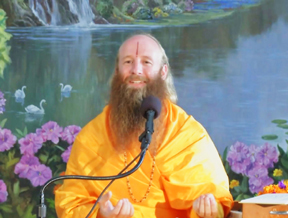 A lot of people think that to believe in God is a matter of personal beliefs, often geared by
A lot of people think that to believe in God is a matter of personal beliefs, often geared by
blind faith. However, it is perfectly logical to believe in God. In fact, believing in God is as scientific as believing in the existence of a country to which you have never been or a sub-particle you have never seen.
There is more than one acceptable form of proof that is used in both scientific and spiritual matters. The forms of proof are called pratyaksh praman (perceptual evidence), anuman praman (inferential evidence) and shabd praman (testimonial evidence).
If we were to rely only on pratyaksh praman (“I will believe it when I see it.”), then there is very little in this world that we would accept as true. For example, we have no perceptual evidence that the force of gravity actually exists. In other words, no one has ever seen gravity – we have only seen the effect of gravity and have thus inferred its existence. In this case, scientists have accepted the existence of something without having direct or eyewitness proof – they have relied on inferential evidence.
There is something else which even extremely rational, scientific thinkers tend to accept without having either perceptual or inferential evidence: who their mother and father are. Since no one can remember being born, no one has perceptual evidence of who their parents are; and since almost no one has a DNA test performed to verify the identity of their parents, very few people have inferential evidence of who their parents are. Then on what basis do we accept our mother and father? We take their word for it.
They have told us, and we believe them. In other words, we are relying on testimonial evidence.
In general, when we accept the existence of something based on testimonial evidence, that is called “having faith”. We are taking someone else’s word for it. We have faith that our parents are who they say they are because we trust them. It is something we choose to believe, because we trust the person providing the testimonial evidence. Thus, having faith in something can have a rational basis – it is not necessarily a blind acceptance. Based on other forms of evidence, we decide to believe in something we have not seen with our own eyes.
Having faith (based on testimonial evidence) also does not exclude the “believer” from gaining other forms of proof at a later time. In many cases, accepting testimonial evidence (or having faith) is the basis for gaining inferential and perceptual evidence. For example, many great scientists have seen molecules, atoms, and electrons, etc. with help of various high powered microscopes. They have direct perceptual evidence of the existence of these things. They are the experts in this field, and their experiences (they have seen, or perceived these things, and thus have the direct experience of their existence) are accepted as evidence by the rest of us, who have not had these advanced experiences.
Many such expert scientists corroborate each others’ experiences, thus giving even more confidence to lay people of the validity of this testimonial evidence. If a science student in 6th grade were to refuse to accept the existence of these molecules, etc. because he has never seen them with his own eyes, he may say that, “I refuse to have blind faith. I will not accept the existence of something based on another’s word. I must see it for myself, and only then will I believe it. Teacher, please stop your lesson until you have shown me these things. Once I have seen them with my own eyes, then I will believe they exist, and you can go on teaching me about them.”
The teacher may admire the student’s determination to verify things with his own experience, but will explain to him that there is a process to be followed to gain such “eyewitness proof” or “direct perceptual evidence” (pratyaksh praman). He would explain that with his current level of understanding, even if he were to show him an electron, he would not understand what he was seeing. He has to become qualified to have such a direct experience by following in the footsteps of the great scientists who have gone before.
Once he reaches their level, then he can get his own direct experience which will verify the existence of these things, and further corroborate the findings of the earlier scientists.
So first the student has to rely on the testimonial evidence provided by the experts in that field. This faith becomes the basis for his study, and can later be verified with his own experience, once he becomes qualified.
Without this initial faith, or reliance on testimonial evidence, the student can’t take even one step towards his end goal of experiencing that tattva for himself (a tattva is an existing thing, substance, or energy). He will remain forever stalled at that initial beginner level.
In the next article, we will learn how these three kinds of evidence can be used to prove the existence of God.
Disciple of Jagadguru Shree Kripaluji Maharaj
Swami Nikhilanand Ji is a Canadian born Hindu spiritual leader based in Austin, Texas. He is a sanyasi disciple and pracharak of Jagadguru Shree Kripaluji Maharaj.
Attracted to the teachings of Hinduism from a young age, Swamiji eventually let his deep spiritual longing lead him to India, where he was most fortunate to come under the guidance of Shree Kripaluji Maharaj. Thereafter, living in the ashrams of JKP, he extensively studied Hindi, the philosophy of the prime Sanskrit scriptures (Vedas, Darshan Shastras, Gita, Bhagwatam), and practiced meditation in the tradition of raganuga bhakti. In 2003, he was given sanyas.
Now, with the blessings of his Guruji, he offers satsang programs throughout America, engaging audiences with his clear explanations of Hindu philosophy coupled with inspired chanting of Sanskrit mantras and shlokas and charming nam sankirtan. His informative and compelling speeches provide practical insight into how to adopt the teachings of Sanatan Dharm into our daily lives, and inspire us to awaken our inner spiritual potential.
To stay in touch with Swami Nikhilanand Ji, like his Facebook page at https://www.facebook.com/SwamiNikhilanand or follow him on twitter at https://twitter.com/Swami_Nikhil.
Swami Nikhilanand






